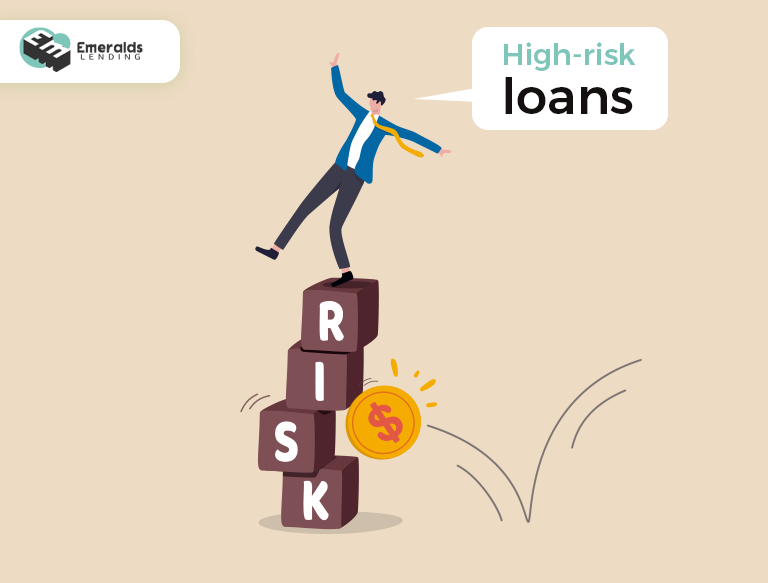A high-risk loan is a financing tool with a higher default probability. Many reasons justify the high default risk, but primarily it's a borrower's bad or no credit score.
High-risk loans are especially for those with defective ratings, no collateral, or a low monthly paycheck. With high-risk loans, the lender takes on extra risk by qualifying borrowers who are more likely to default on debt repayment.
Indeed, the lender's objective is to recoup his investment plus calculated interest through financing vulnerable borrowers. However, borrowers with low FICO scores are usually considered high-risk; thus, the phrase "high risk" is coined.
Most lenders usually charge higher interest rates and fees to offset the financing risk. According to traditional lending standards, bad credit financing is considered too risky and should be considered a last resort financing option.
Let's find out what counts as a high-risk debt and what financing solutions you may have with bad or no credit.
Who is a High-Risk Borrower?
In simple terms, a high-risk borrower is more likely to either default on debt payments or otherwise not meet contractual obligations on time. Most commonly, high-risk borrowers are those with low ratings. A scoring result is a three-digit numerical expression that depicts the borrower's borrowing power. For example, according to the FICO Scores (ranges between 300 and 850), a rating below the scale of 580 is regarded as bad or poor. Apparently, most lenders will qualify you as a high-risk borrower if your score dips in the risk level. Here are key factors that go into the FICO Score calculation:
Payment History
Payment history is the primary consideration factor in the FICO score that counts for 35% of your score. Therefore, making on-time payments on all your debts is vital to maintaining a good rating. Even one single late payment will be reported to data collection agencies and consequently lower your score. To avoid late payments on your debt, you may set up automatic payments directly from your account.
Amounts Owed
Keeping the credit utilization ratio low is the second most important thing to consider (makes up 30% of the FICO score). Most financial experts usually recommend having it below 30%; the lower, the better. The best way to lower your utilization ratio is to pay off your debt balance every month. However, you may ask for a credit limit increase not to keep the debt balance close to its limit.
Length of Credit History
Length of credit history shows the period you have been using financing. Indeed, the longer your history, the better it affects your score. The history length makes up 15% of a FICO score. To generate your rating, FICO requires an active account that has been active for at least six months. So, although the history length isn't a primary factor going into FICO score calculation, keeping your accounts in good standing is essential. Also, keep in mind not to open or close bank accounts unnecessarily as it can lower your score as well.
Credit Mix
Although a credit mix counts only 10% of your overall score, it can still be helpful. This factor includes various types of accounts you may have on your financial report. For many lenders and bureaus having that mix indicates how well you can manage your debt and how responsible you are with having different accounts. All your installment tools, mortgages, and retail accounts fall into the FICO score calculation. However, it doesn't mean that having one of each is mandatory.
New Credit
The last 10% of a FICO score counts for new applications. This component generally is computed by examining how frequently you have applied for financing in one year. Every time you submit a new request, a hard inquiry shows up on your report. This lowers your score somewhat with each financing request.
High-Risk Loans Are Unsecured Form of Lending
High-risk funding is usually considered a form of unsecured debt, meaning no collateral (such as valuable possession, property, or car) is required to protect the lender against nonpayment. Therefore, you don't risk your assets if you fail to pay back a high-risk debt. However, on the other hand, high-risk tools feature relatively high-interest rates to offset the default risk.
If a borrower makes on-time payments, he may use high-risk loans to improve his score and qualify for better terms in the future. But if he falls behind on a repayment plan or otherwise defaults on debt repayment, he may end up in debt with derogatory marks on a financial report.
Alternatives to High-Risk Loans
Most traditional lenders use FICO scoring to help them consider the borrower's credit risk. That's why those with high-risk profiles are less likely to get a good deal on quick funding. As a result, many alternative lenders have sprung up to fill this need. Here are the most common alternatives to high-risk loans when you require a fair chunk of cash with bad or no credit.

A Secured Personal Loan
One of the best options to qualify for funding with a less-than-perfect score is to opt for a secured personal loan. These are more likely to offer better terms compared to sketchy lenders. However, with a secured form of lending, you hold the risk of losing the collateral if you fail to pay off debt on time. With secured loans, you may still qualify for quick funding even if you have a low FICO score since you put up collateral. If you default on debt repayment, lenders may not only replace your property but also report nonpayment information to major bureaus.
Important to know: Accounts sent to collection agencies may stay on your financial report for up to seven years.
Cosigner
Adding a cosigner to help get financing is the next option you may choose over the high-risk loan. Most conventional lenders offer to get a personal loan with a cosigner to add more protection against defaulting on debt. In simple terms, a cosigner is an additional hook to pay back the debt. Thus, you may locate someone with a strong repayment history and a stable monthly paycheck to cosign your borrowing. With a consigner getting unsecured financing won't be an impossible task to complete. Cosigning a loan itself does not boost or otherwise lower your rating, but if a borrower defaults on debt payment, you may expect a considerable score drop.
Credit Cards
You may have multiple options to qualify for cash with bad or no credit with a credit card. The first option is to get a secured credit card and obtain financing against backed collateral. However, similar to a secured personal loan, you may still risk your assets in case of nonpayment. Alternatively, you may opt for a credit card for bad credit but expect relatively high-interest rates. And the third option is to become an authorized user on someone else's card.
Credit Union
Although credit unions usually fall into the same labor as traditional lenders, they may still be a useful alternative for those with less-than-perfect ratings. Most credit unions use different factors rather than only a score to qualify your portfolio. Thus don't hurry to consider a high-risk loan your last resort as credit union loans may come into practice.
Online Loans
Get pre-qualified for an online loan with no traditional checks. The main advantage of online lending is that you can fill out multiple financing requests without damaging your score. Plus, online funding features incomparably quick and straightforward application processing that you may complete from the comfort of your home.
High Risk Always Means Bad Credit
Having a low FICO score may limit your financing options and finally, result in more expensive funding offers featuring higher interest rates and lower loan amounts.
Here are some key steps you may take to qualify for a cash advance with bad credit:
Check Your Report Regularly: Almost any lender will look at your financial report to consider how likely you are to pay off the loan on time. Thus, knowing the real chances of getting quick financing is essential before submitting the financing request. At annualcreditreport.com, you may get a free report once a year from each of three major bureaus: Equifax, Experian, and TransUnion.
Prove Your Debt Repayment Ability: Although most lenders consider your score to determine your borrowing power, it's also important to provide additional guarantees, such as providing income proof, backing up with collateral, or having a cosigner. All these will add more confidence that you will end up paying debt on time.
Check Eligibility Criteria: Look at the minimum requirements to make sure you comply with them. For example, being rejected for a loan will not likely impact your score, but a hard inquiry that popped up on your report will bring your score down.
Shop Around: To ensure which option will work best for you, research before initiating a loan request. Look at the terms and, more importantly, repayment methods. For instance, if you opt for an installment loan, you have equated monthly installments spread over a long period, from some months to a couple of years. While with payday financing, you have to pay off the entire debt all at once upon your next paycheck.
What's the Easiest Loan to Get with Bad Credit?
Despite bad or no credit, you may still have an opportunity to get quick financing from different lenders: Here are some of the most popular options out there:
HELOC
Home equity line of credit, as the name suggests, is a secured form of financing that uses your home to back up your debt. Instead of targeting your FICO score, the lender puts the accent on the equity in your home. HELOC is a popular method to secure cash against your equity. However, you may risk your assets if you fail to pay off debt.
Unsecured Personal Loans
Indeed, most personal advances available to get from traditional lenders are based on the borrower's trustworthiness. However, you may find personal loans for bad credit with online lenders.
Payday Loan for Bad Credit
If you are struggling with a low FICO score but still require quick cash to get through a financial emergency, a payday advance may be a good alternative to decide on. In general, payday loans are unsecured personal financing available to get online from the comfort of your home. At Emeraldslending, you can submit your financing request and get up to $2500 cash from online lenders as soon as in one business day.
Advantages of High-Risk Funding
Repair Your Credit to Increase Your FICO Score
Having derogatory marks on a credit report is one of the primary reasons you cannot qualify for conventional financing. On the other hand, a high-risk loan may help get quick funding and start the credit repair process. In addition, making regular payments even on a high-risk debt may provide an opportunity to form a strong financial standing.
You can Borrow Large Amounts of Money
Another benefit of taking out a high-risk loan is qualifying for larger sums for relatively short periods. However, keep in mind, that the more cash you borrow, the more you will end up paying on interest.
You May Get Very Quick Approval
High-risk loans offer incomparably higher approval rates since most lenders don't employ hard checks to qualify borrowers. Thus, you do not need to be concerned about financial mistakes reflected in your credit report.
Is a High-Risk Loan a Good Idea?
Payday financing is an excellent alternative to conventional lending if you look for a fair chunk of cash for bad credit. Although bad credit lenders usually charge higher interest rates and related fees, they consider other factors rather than solely targeting your FICO score. However, to summarize, high-risk loans are only worthwhile as a last resort after you've exhausted all financing options.
